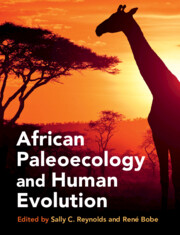Book contents
- African Paleoecology and Human Evolution
- African Paleoecology and Human Evolution
- Copyright page
- Dedication
- Contents
- Contributors
- Acknowledgments
- Part I Modern Africa and Overview of Late Cenozoic Paleoenvironments
- 1 Introduction: African Paleoecology and Human Evolution
- 2 Approaches to the Study of Past Environments
- 3 Environmental and Stratigraphic Bias in the Hominin Fossil Record
- 4 Late Miocene and Earliest Pliocene Paleoecology of Africa
- 5 The Middle Pleistocene Through the Holocene of Africa
- Part II Southern Africa
- Part III Eastern and Central Africa
- Part IV Northern Africa
- Volume References
- Index
- Plate Section (PDF Only)
5 - The Middle Pleistocene Through the Holocene of Africa
A Synthesis
from Part I - Modern Africa and Overview of Late Cenozoic Paleoenvironments
Published online by Cambridge University Press: 19 May 2022
- African Paleoecology and Human Evolution
- African Paleoecology and Human Evolution
- Copyright page
- Dedication
- Contents
- Contributors
- Acknowledgments
- Part I Modern Africa and Overview of Late Cenozoic Paleoenvironments
- 1 Introduction: African Paleoecology and Human Evolution
- 2 Approaches to the Study of Past Environments
- 3 Environmental and Stratigraphic Bias in the Hominin Fossil Record
- 4 Late Miocene and Earliest Pliocene Paleoecology of Africa
- 5 The Middle Pleistocene Through the Holocene of Africa
- Part II Southern Africa
- Part III Eastern and Central Africa
- Part IV Northern Africa
- Volume References
- Index
- Plate Section (PDF Only)
Summary
The last 780,000 years in Africa, the Middle Pleistocene through the Holocene, witnessed several crucial events in hominin evolutionary history. These include: (1) the dissolution of the Acheulean (1.6 Ma to 160 ka) and development of the Middle Stone Age (MSA: ~285 to 50 ka) and Later Stone Age (LSA: from ~50 ka) archaeological industries (Ambrose, 1998; Villa et al., 2012; Tryon and Faith, 2013), (2) the appearance of both archaic and anatomically modern Homo sapiens (reviewed in McBrearty and Brooks, 2000; Wood and Richmond, 2000), and (3) the dispersal of modern humans within and out of Africa (Soares et al., 2012; Rito et al., 2013). These events are thought by many to be mediated by climate-driven environmental change (e.g., Compton, 2011; Potts, 2013; Jones and Stewart, 2016; Timmerman and Friedrich, 2016), although a lack of empirical paleoanthropological evidence (e.g., well-dated hominin remains or archaeological sites) directly associated with paleoenvironmental records obscures our understanding of these relationships. In the absence of such evidence, the faunal record, in addition to being a crucial source of paleoenvironmental data, provides essential ecological and evolutionary context for evaluating climate’s potential role in the more recent phases of human evolution.
- Type
- Chapter
- Information
- African Paleoecology and Human Evolution , pp. 33 - 48Publisher: Cambridge University PressPrint publication year: 2022



